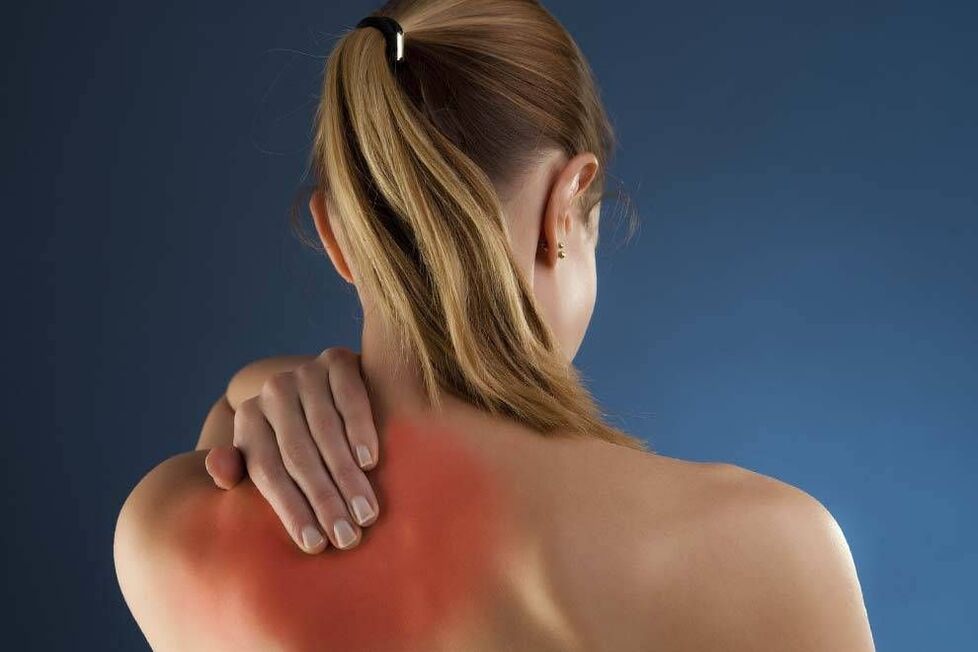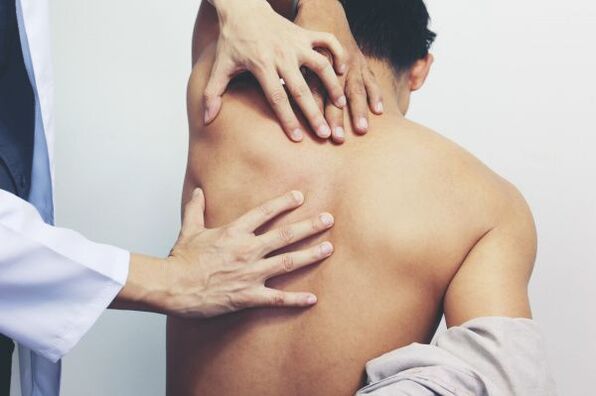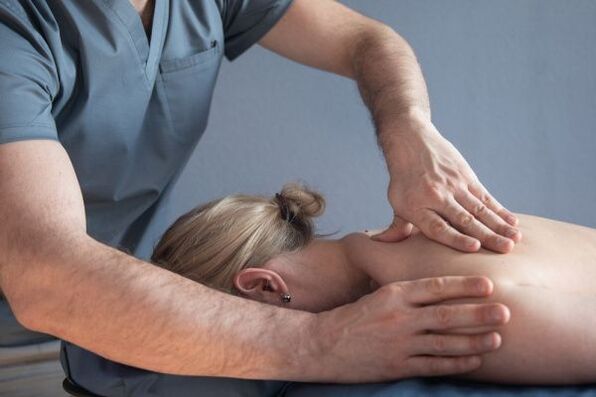
Pain under the left shoulderobserved in musculoskeletal pathologies (osteochondrosis, myofascial syndrome, injuries), heart diseases (myocardial infarction, angina pectoris, rheumatic and non-rheumatic carditis), gastrointestinal diseases (pancreatitis, stomach ulcer). Rare causes of symptoms include damage to the spleen, ulcers, and skin tumors. Diagnostic methods are selected based on the underlying syndrome: X-ray, ultrasound and endoscopic examinations are used. To relieve pain, analgesics are prescribed, after which medical or surgical treatment of the underlying disease is carried out.
Causes of pain under the left shoulder blade
Radicular syndrome
The pathological condition develops with thoracic osteochondrosis or intervertebral hernia. Less commonly, radicular pain occurs with spondylolisthesis and ankylosing spondylitis. Acute pain in the projection of the left shoulder is observed when the 3-6 thoracic roots are involved in the process; discomfort directly under the scapula indicates the location of the damage in the 7-8 vertebrae. Typically, the pain spreads from the scapula to the lateral surface of the chest and intercostal spaces.
Myofascial pain syndrome
Poor posture and prolonged sitting in an uncomfortable position lead to constant muscle tension. The syndrome manifests as pain in the area of the scapula on the left, when the load is mainly on this side. The discomfort is felt by the patient as deep and moderately intense. At first, pain is experienced only during movement and exertion, but over time it becomes constant. Sometimes the radiating pain appears in the forearm or left hand.
INJURY
Intense pain develops after a tear or fracture of the scapula or bruising of the soft tissues over this area. If the integrity of the bone is preserved, the pain is moderate, the person can breathe deeply and move freely. When traumatic damage to bony structures occurs, sharp pain occurs and mobility of the arm and shoulder girdle is often limited. When you change position or press on the damaged area, a sharp pain is felt.

Boils and carbuncles
Purulent inflammation of the skin surrounding the left shoulder blade is accompanied by severe pain, which, as a rule, is clearly localized. As the boil matures, "pulling" sensations occur, which intensify when the area of inflammation is palpated or rubbed with clothing. After the tire bursts and the necrotic core comes out, the pain subsides. With a carbuncle, the pain is more intense and the general condition of the patient often worsens.
Heart dissases
Heart damage is a typical cause of pain under the left scapula, which is associated with the proximity of the anatomical location and innervation characteristics. In this case, the symptoms are accompanied by pain in the chest of various types, a feeling of freezing or interruption in the functioning of the heart. Tachycardia and other rhythm disorders are usually detected. Pain under the shoulder blade manifests as:
- Myocardial infarction.Patients experience unbearable burning sensations that spread from the precordial region to the left arm and shoulder blade, and less often to the clavicle and neck area. The condition appears suddenly and is accompanied by a strong fear of death and a fainting state.
- Stable angina.Episodes of squeezing or pressing pain radiating to the subscapular area are specific to attacks of ischemic heart disease. Unpleasant symptoms are provoked by physical activity or emotional stress and last on average up to 10-15 minutes. After rest or taking nitrates, the pain disappears.
- Inflammatory heart diseases.Dull or stabbing pain in the chest, which radiates to the left shoulder and bothers the patient for several days, is typical of acute carditis (myocarditis, pericarditis). The person also complains of shortness of breath, increased body temperature and swelling of the lower extremities.
- Rheumatism.Radiating pain in the left half of the back in combination with cardialgia is characteristic of the clinical picture of rheumatic carditis. The clinical picture is completed by arthralgia, ring-shaped erythema on the skin and rheumatic joints. Symptoms are more often detected in children and adolescents.
Pancreatitis
Band pain moving from the left hypochondrium to the subscapular region is observed with acute inflammation of the pancreas. In addition to the pain syndrome, patients are concerned about debilitating vomiting with impurities of bile and mucus, as well as tension in the abdominal muscles. Movement increases painful sensations, so the person tries to lie on his side without movement.
In chronic pancreatitis, radiating pain under the scapula indicates a worsening of the process. Often, violations are provoked by mistakes in the diet - a big party, drinking alcohol. The pain is of a paroxysmal nature, sometimes spreads not only to the subscapularis, but also to the precordial region. Symptoms are combined with nausea, bloating and steatorrhea.
Stomach ulcer
Pain under the left shoulder blade is a sign of localization of the defect in the back wall of the stomach, closer to the back. Unpleasant sensations appear within 20-50 minutes after the end of the meal. The earlier the symptoms appear, the higher the location of the ulcer. The anxiety gets worse when you eat sour, spicy or fried foods. To reduce the intensity of pain, patients induce vomiting.
Diseases of the spleen
Pain and a feeling of fullness in the left subscapular area occur with splenomegaly caused by infectious, autoimmune or myeloproliferative processes. With the gradual expansion of the organ, periodic discomfort develops with heaviness in the affected area, and a rapid change in the size of the spleen is accompanied by sharp cutting pains radiating under the left shoulder blade.
Somewhat less often, the cause of pain is surgical pathologies of the spleen: rupture, infarction, volvulus. In this case, there are cutting or throbbing pains that radiate under the scapula, which are aggravated by the slightest movement. Therefore, the patient takes a forced position: lying on the left side or on the back with knees placed on the stomach. The clinical picture is completed by a sharp drop in blood pressure and tachycardia. In the absence of adequate pain relief, shock occurs.
Bronchopulmonary pathologies
Left-sided focal processes in the lungs often cause pain in the projection of the scapula. The discomfort increases with deep breathing, laughing and talking and with coughing fits. Pain has a varied nature: sharp, stabbing, dull, pressing. They are accompanied by fever, shortness of breath and other typical respiratory symptoms. Most often, pain under the left shoulder is experienced by patients who develop:
- Pneumonia.The patient feels a moderate dull pain, which has a clear localization in case of focal lung inflammation or spreads to the entire scapular area in case of lobar pneumonia. A deep cough appears with the release of mucopurulent sputum. Symptoms last up to 2-4 weeks.
- Pleurisy.With exudative pleurisy, a person experiences pressure and eruption under the scapula and along the side wall of the chest. When you feel this area, the discomfort intensifies. Dry pleurisy is characterized by acute pain in the chest and in the subscapular area, aggravated during movements.
- Tuberculosis.Tuberculosis infection lasts a long time, so low-intensity pains continue for several months. If the pain is localized in the area of the scapula, the pathological focus is more likely to be located in the posterior segments of the lungs.
- Pulmonary infarction.The death of a section of the pulmonary parenchyma is manifested by severe pain radiating under the left shoulder blade, which clinically resembles an angina attack. The patient's condition is complicated by hemoptysis or pulmonary hemorrhage, external respiratory dysfunction, and arrhythmias.
Rare causes
- Neoplasms: osteoma and osteosarcoma, bone cyst, malignant skin tumors on the shoulder (basal cell carcinoma, melanoma).
- Rare cardiovascular pathologies: cardiac syndrome X, aneurysm of the descending aorta.
- Acute surgical diseases: retroperitoneal abscess, hemoperitoneum, strangulated diaphragmatic hernia.
Diagnosing
Patients with pain under the left shoulder blade are first referred for consultation to an orthopedic traumatologist. If there are no disorders of the musculoskeletal system, other specialists are involved in the diagnostic research: neurologist, cardiologist, surgeon, etc. To determine the causes of pain, a full range of instrumental studies is prescribed, which includes:
- Radiography.An X-ray of the scapula in frontal and lateral projections allows one to exclude or confirm traumatic injury. Radiographic imaging of the spine is indicated for suspected osteochondrosis, scoliosis, or spondylolisthesis. Plain radiography of the chest cavity allows suspicion of lung or heart damage.
- Electrocardiogram.A standard 12-lead ECG is a screening method, based on the results of which the doctor makes a preliminary diagnosis and identifies dangerous processes (myocardial infarction, life-threatening arrhythmias). The diagnostic complex is completed by classic or transesophageal echocardiography and cardiac electrophysiology.
- Abdominal ultrasound.A quick and non-invasive method is used to detect common conditions that cause pain in the left shoulder blade. Ultrasound examination shows signs of gastric ulcer, inflammatory infiltration of the pancreas and splenic enlargement. To clarify the diagnosis of peptic ulcer, EGD is used.
- Additional Methods. To clarify the nature and severity of bone changes, a CT or MRI of the spine is performed. In case of possible bronchopulmonary diseases, bronchoscopy with biopsy and pleural puncture is performed. If there are difficulties in diagnosing abdominal pathology, diagnostic laparoscopy is recommended.
Laboratory examination methods play a major role in establishing a diagnosis. A clinical blood test shows signs of inflammation or disruption of hematopoietic processes. Indicators of proteins and proteinograms of the acute phase are informative in case of possible heart damage or an autoimmune process. Specific myocardial markers for angina pain are evaluated.
To diagnose gastrointestinal diseases, a coprogram is performed: the presence of pancreatitis is indicated by a high content of undigested food particles, an increase in the number of striated muscle fibers and starch grains. In case of inflammatory processes of the lungs and pleura, bacteriological seeding of the biomaterial is necessary, followed by a test for the sensitivity of the isolated microorganisms to antibiotics.

Treatment
Help before diagnosis
Considering the variety of causes of pain under the left shoulder blade, it is extremely difficult for a doctor to give recommendations until the underlying pathology is identified. During the examination, it is advisable to reduce the load on the back muscles to eliminate simple fatigue and overstrain, which can cause persistent pain symptoms. If the sensations are unbearable, analgesics are used and the patient is hospitalized immediately.
Conservative therapy
The treatment plan is selected only after a complete diagnosis and determination of the etiological factors of pain under the left shoulder blade. If the patient suffers from severe discomfort, anti-inflammatory and muscle relaxant drugs are recommended, which quickly relieve painful sensations. For severe pain, therapeutic blockades and administration of narcotic analgesics are effective. Taking into account the disease, a mode of physical activity is chosen.
Drug therapy is prescribed by a specialist of the appropriate profile. For pain due to heart damage, the cardiologist prescribes antianginal and antiarrhythmic drugs, antiplatelet and antihypertensive agents and anticoagulants. Diseases of the bronchopulmonary system require the participation of a pulmonologist and the use of antibiotics, expectorants and specific drugs against tuberculosis.
For gastrointestinal pathologies, a suitable diet is chosen and the therapy is supplemented with enzymatic preparations, prokinetic preparations, antacids and antisecretory medications. In neurology, neurometabolic agents, B vitamins and drugs that improve microcirculation and blood rheological properties are indicated to eliminate radicular syndrome.
For postural disorders and other spine problems, drug-free methods are actively used: traction therapy, therapeutic massage, exercise therapy. Among the physiotherapeutic methods, balneotherapy (sulfide and radon baths), mud therapy and reflexology are popular. It is possible to increase the effectiveness of drug treatment by electrophoresis of drugs directly in the affected area.
Surgery
Surgical methods are indicated when conservative treatment is ineffective or in acute life-threatening pathology, when the delay is dangerous for the patient's life and health. The second group of operations includes methods of stenting, angioplasty and bypass surgery for myocardial infarction, assistance of abdominal or thoracic surgeons for injuries, purulent processes and internal bleeding.
Planned surgical interventions are often prescribed in neurosurgery for severe radicular syndrome and intervertebral hernia. To eliminate pain associated with compression of nerve structures, microdiscectomy and laser vaporization of the disc is performed. In rare cases, stabilizing operations on the spine are used (interbody fusion, application of a Halo device, transpedicular fixation).

















































